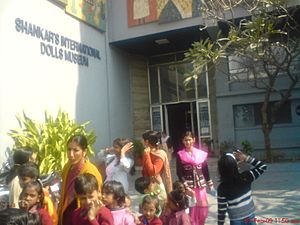Shankar's International Dolls Museum facts for kids
 |
|
| Established | 30 November 1965 |
|---|---|
| Location | Nehru House, 4 Bahadur Shah Zafar Marg, New Delhi-110002 |
| Collection size | 6,500 Dolls |
The International Dolls Museum in Delhi, India, is a wonderful place filled with dolls from all over the world. It was created by a famous political cartoonist named K. Shankar Pillai. The museum is located inside the Children's Book Trust building. You enter through a special door and go up a winding staircase to reach it. The museum covers a large area, taking up part of the first floor.
Contents
History of the Dolls Museum
How the Museum Started
K. Shankar Pillai, often called Shankar, was a well-known cartoonist. In 1957, he started the Children's Book Trust. This organization helped create children's books in India.
One day, a diplomat from Hungary gave Shankar a doll as a gift. This gift gave Shankar an amazing idea: he decided to start collecting dolls from all the countries he visited. He loved to show these dolls to children, especially those who didn't have many toys.
At one of his doll exhibitions in Delhi, the Prime Minister at the time, Jawaharlal Nehru, visited with his daughter, Indira Gandhi. Indira was very inspired by the dolls. She and Shankar then worked together to create an international museum just for dolls. This dream came true on November 30, 1965.
Growing Collection of Dolls
Many dolls in the museum were gifts from important people. Prime Minister Jawaharlal Nehru gave some, and so did later Prime Ministers like Indira Gandhi and Rajiv Gandhi. Embassies and diplomats in Delhi also donated dolls. Important visitors from other countries, like Madame Tito and the Queen of Greece, also gifted dolls that represented their nations.
The museum was officially opened by Dr. S. Radhakrishnan, who was the President of India. At that time, in 1965, there were about 500 dolls. Between 1965 and 1987, the number of dolls grew to 5,000! Most of these were gifts. Shankar Pillai was even given a high award by the Indian government in 1976 for his work.
Today, the museum has about 6,500 dolls from nearly 85 different countries. This makes it a truly international collection!
Where to Find the Museum
The museum is located in the Children's Book Trust building. This building is on Bahadur Shah Zafar Marg in New Delhi. It's near a place called Ram Charan Agrawal Chowk. The museum is on the first floor and has its own entrance with a winding staircase.
Inside the Museum
How the Museum is Set Up
The museum is divided into two main sections. These sections have more than 160 glass display cases. These cases are mounted on the walls and stretch for a long distance.
One section of the museum displays dolls from Europe, the United States, Australia, New Zealand, and countries that were once part of the Soviet Union. The other section features dolls from Asian countries, the Middle East, Africa, and India.
What You Can See in the Collection
The dolls are grouped into two main parts. One part shows dolls from Western countries like the UK, USA, and Australia. The other part shows dolls from Asian and African countries, including India.
A very special part of the collection is the 150 types of Indian costume dolls. These dolls are made right at the museum's own workshop! The artists who make them pay close attention to every detail. They make sure the dolls' features, clothes, and jewelry are perfect. You can see dolls dressed as characters from India's famous classical dance, Kathakali, with their amazing costumes.
Other interesting dolls include:
- Boys and Girls Festival dolls from Japan.
- Replica dolls from the Queen's collection in the UK.
- Dolls showing the Maypole Dance from Hungary.
- Kabuki and Samurai dolls from Japan.
- Flamenco dancers from Spain.
- A women's orchestra from Thailand.
- Dolls showing the Kandy Perahera festival from Sri Lanka.
The dolls from this museum even won a special award called the Golden Peacock Feather in Poland in 1980!
Besides dolls from different countries, there's a special display of over 150 dolls wearing Indian costumes. These dolls show various Indian dances, cultures, and regional clothing. You can see pairs of brides and grooms from different states. There's even a group of dolls showing how to wear a saree! These dolls are all made at the workshop connected to the museum.
The Indian dolls made at the workshop are sometimes traded for dolls from other countries. They are also sold to collectors and other museums in India and around the world. Each doll is made by hand after careful research to make sure it looks just right. The museum also has a "clinic" for "sick" dolls. Here, old or damaged dolls are carefully repaired and brought back to life.
Visiting Hours
The museum is open from 10:00 AM to 6:00 PM. There is no lunch break, so you can visit anytime during these hours. The ticket counter closes at 5:30 PM. The museum is closed on Mondays and on other public holidays.
See also
- Rajkot - doll museum

